the place where Paleontology and Paleoanthropology meets Philately
Croatia
Dinosaurs, prehistoric animals and paleontologist on stamps and postmarks of Croatia
| << previous country | back to index | next country >> |
Contents:
- Country overview
- Philately of Croatia
- Official stamps of Croatia related to Paleontology
- Other stamps of Croatia to consider
- Post stationery of Croatia related to Paleontology and Paleoanthropology
- Commemorative covers of Croatia related to Paleontology
- Other commemorative covers of Croatia to consider
- Commemorative postmarks of Croatia related to Paleontology
- Other postmarks of Croatia to consider
- References
- Acknowledgements
Croatia, officially the Republic of Croatia, is a sovereign state at the crossroads of Central Europe, Southeast Europe, and the Mediterranean. Its capital city is Zagreb, which forms one of the country's primary subdivisions, along with its twenty counties.
Croatia covers 56,594 square kilometers and has diverse, mostly continental and Mediterranean climates. Croatia's Adriatic Sea coast contains more than a thousand islands. The country's population is 4.28 million, most of whom are Croats, with the most common religious denomination being Roman Catholicism.
After the World War II, Croatia became a founding member and a federal constituent of Socialist Federal Republic of Yugoslavia, a constitutionally socialist state.
On 25 June 1991 Croatia declared independence, which came wholly into effect on 8 October of the same year. The Croatian War of Independence was fought successfully during the four years following the declaration. [R1]
With the resumption of independence in 1991, the Republic of Croatia again reinstated the Croatian Post. The first new postage stamp being an airmail issued 9 September 1991 and with the first new regular postage stamp being issued on 21 November 1991. [R2]
During 1991 both Yugoslavian and Croatian stamps were in use in the country. Nowadays Croatia issues 40-50 stamps a year of various topic related its cultural and natural heritages, include Paleontological and Paleanthropological finds.
There are many stamps and postmarks that show the Krapina Neanderthal Man [R3] and Dragutin Gorjanović-Kramberger [R4] who discovered Neanderthal remains in a cave on Husnjak hill near to Krapina town. Krapina Neanderthals site at the Hušnjakovo locality is the first paleontological natural monument in Croatia and is one of the most significant paleoanthropological localities worldwide. Since September 1971 the Museum of Evolution was opened to public.
Official stamps of Croatia related to Paleontology: dinosaurs and other prehistoric animals, fossils, paleontologists.
| 07.03.1994 "Dinosaurs from Western Istria" | 30.10.1995 "Croatian Scientist" [1] | 04.10.1996 "Scientist" [2] |
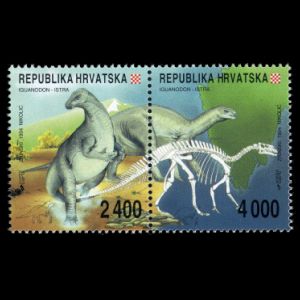 |
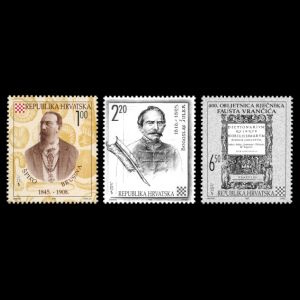 |
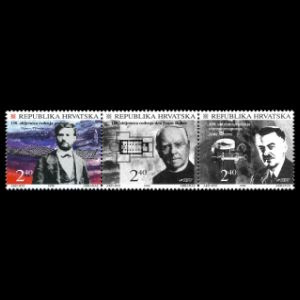 |
| 06.11.1997 "Paleontological Finds in Croatia" | 23.08.1999 "Discovery of Early Primitive Krapina Man" | 07.11.2012 "Museum of Krapina Neanderthal Man" |
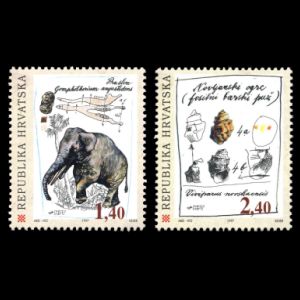 |
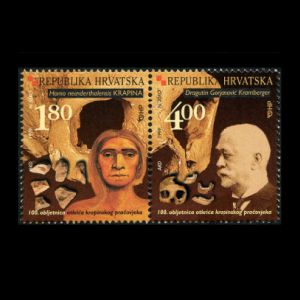 |
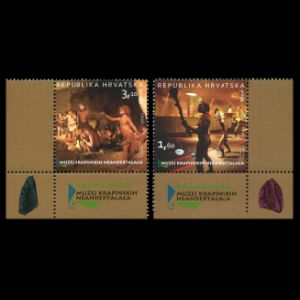
|
| 12.10.2016 "PALAEONTOLOGY" | ||
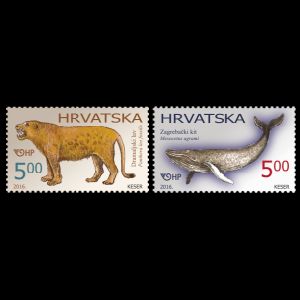 |
|
|
Notes:
[1]
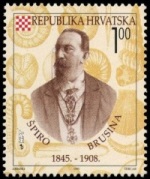
|
|
Spiridion Brusina on stamp of Croatia 1994, MiNr.: 349, Scott: 269 |
He was among the first to notice the importance of scientific research into the depths of the Adriatic and claimed the sea was a source of life and living species. He was founder of maritime biology in Croatia. He was particularly interested in birds and set up the beginnings of ornithology in Croatia. He analyzed and classified 600 fossil species. He has a great merit for popularizing science in Croatia. Natural scientists throughout Europe named in his honor about 50 species according to his name. [R5]
[2] First stamp of the set, with face value of 2.40, depict Gjuro Pilar who was born in Slavonski Brod in 1846.
After completing his education at grammar school in Osijek and Zagreb he studied natural sciences in Brussels, where he also received his doctoral degree at the age of 22.
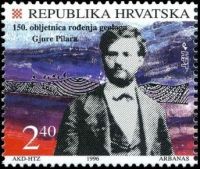
|
|
Gjuro Pilar on stamp of Croatia 1996, MiNr.: 394, Scott: 311a |
Other stamps of Croatia to consider
| 22.10.2020 "Minerals and Rocks" [A1] | ||
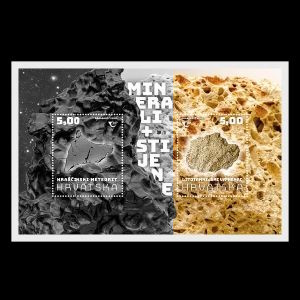 |
|
|
Notes:
[A1] The Mini-Sheet "Minerals & Rocks 2020" contains two stamps: The Hraschina Meteorite and Lithothamnium limestone (on the right side of the Mini-Sheet).
Lithothamnium limestone, called “litavac” for short in Croatian, is a sedimentary rock. This massive, porous type of limestone is mostly composed of red algae of the Lithothamnium order that inhabited the Paratethys Sea 15 million years ago, in Middle Miocene. The limestone’s name is derived from the algae, in addition to which it contains the remains of bivalves, echinoderms, bryozoans and benthic foraminifera. Apart from the remains of sea organisms, Lithothamnium limestone contains fragments of quartz and calcite, mica flakes and fragments of rocks from the coastal area. Lithothamnium limestone was formed in the shallows of the Pannonian Sea, which surrounded Medvednica and other Pannonian Croatia mountains, which were islands at the time.
Along with Triassic dolomites, Lithothamnium limestone forms a unique karst zone on the west side of Mount Medvednica. Even though karst phenomena on Mount Medvednica are mostly hidden under younger Holocene deposits, many karst forms such as caves, pits, sinkholes and karst valleys are still present in this zone.
More details are here.
Post stationery of Croatia related to Paleontology: contributor to Paleontology science
| 2013 "50th anniversary of death of Ivo Horvat" [PS1] | ||
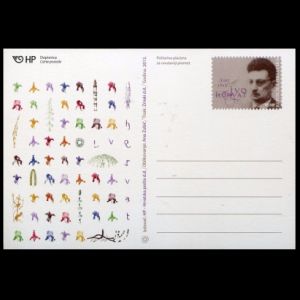 |
|
|
Notes:
[PS1] Ivo Horvat was Croatian botanist who studied not only modern but also prehistoric fossilized plants, as mentioned on the reverse side of the cover:
"In 1925 he announced his first work in phytocenology in Croatia (Plant Sociology) entitled "About vegetation Pljesevica in Lika", which is chosen for phytosanitary access and flow of all life evolves, reflecting his approach, which opens new insights into the development of vegetation, fossil, sineological and phytoecological analysis to ecological and vegetational mapping of vegetation in Croatia ..."
Commemorative covers of Croatia related to Paleontology: dinosaurs and other prehistoric animals, fossils, paleontologists
| 25.10.1991 "135th anniversary of Dragutin Gorjanović-Kramberger". Issued with commemorative postmark by Philatelic Club of Virje. [Cov1] |
12.02.1994 "185th anniversary of Charles Darwin". Issued with commemorative postmark by Philatelic Club of Virje. |
13.11.1995 "Philatelic exhibition: Prehistoric animals on stamps at Cakovec". Issued with commemorative postmark by Philatelic Club "Zrinski" of Cakovec |
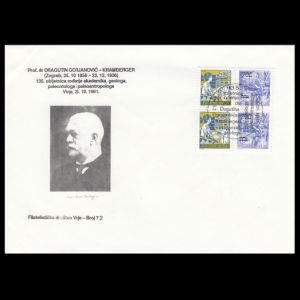 |
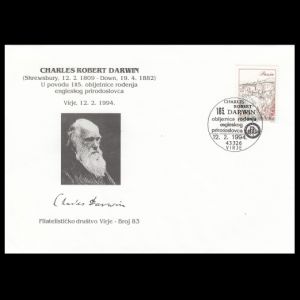 |
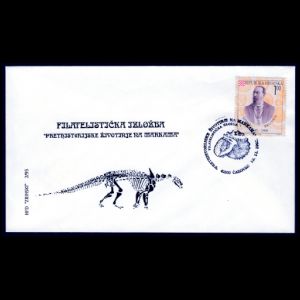 |
| 08.11.1997 "1st Intercity Philatelic exhibition at Novska". Issued with commemorative postmark by local Philatelic Club |
15.03-31.03.1998 "Philatelic exhibition: Dinosaurus on stamps at Cakovec". Issued with commemorative postmark by Philatelic Club "Zrinski" of Cakovec |
|
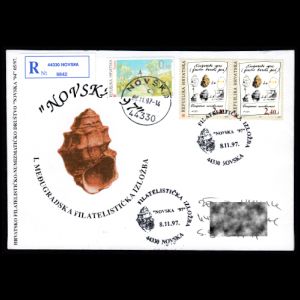 |
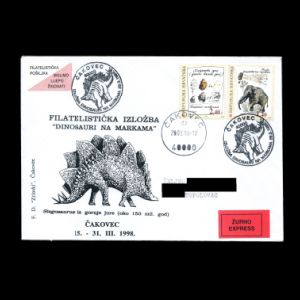 |
|
Notes:
[Cov1] The cover was made in transitional period, shortly after Croatia earned independence from Yugoslavia, therefor it has a mix of Yugoslavian stamps and Croatian postmark. The first regular postage stamp of modern Croatia issued on 21 November 1991, a month after the cover was issued. The text is from the inside page of the cover
Other commemorative covers of Croatia to consider: contributors to Paleontology science.
| 12.10.2005 "100th anniversary of Stjepan Vukovic" [Covo1] | 23.04.2013 "50 year of death of Dr. Ivo Horvat" Issued with commemorative postmark by City museum (Gradski muzej) of Cazma. [Ps1] |
|
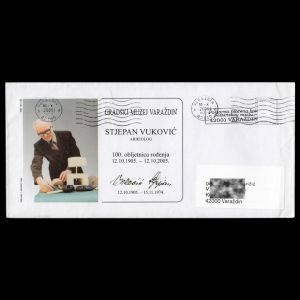 |
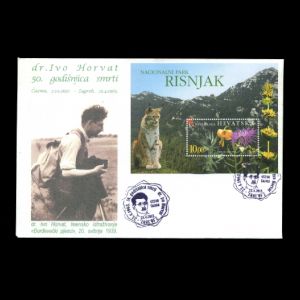 |
|
Notes:
[Covo1] "Ever since his early days as a teacher, while he was still working the villages surrounding Varazdin, Stjepan Vukovic pursued the oldest history of the region. He traversed the backward areas, unearthed archaeological and palentological finds, collected geological pieces and fossils, and kept records of his findings and their locations. As early as 1938, his rich private collection became apart of museum fund which will be used as the basis for the Prehistoric, and later the Archaeological wing of the Varazdin City Museum... "
The text is from the reverse side of the cover.
Postmarks of Croatia related to Paleontology: dinosaurs and other prehistoric animals, fossils, paleontologists.
Legend is here
| 25.10.1991 "135th anniversary of Dragutin Gorjanović-Kramberger" [PM1] [Sp] | 12.02.1994 "185th anniversary of Charles Darwin birthday" [Sp] | 07.03.1994 "Dinosaurs from Western Istria" [FDC] |
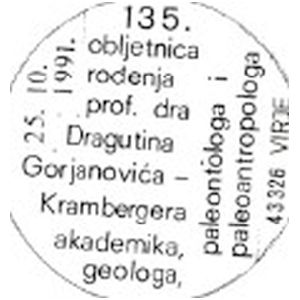 |
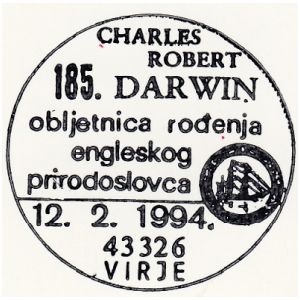 |
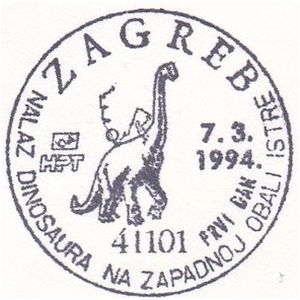 |
| 07.03.1994 "Dinosaurs from Western Istria" [Sp] | 12.03.1994 "Philately exhibit at Cakovec" [Sp] | |
 |
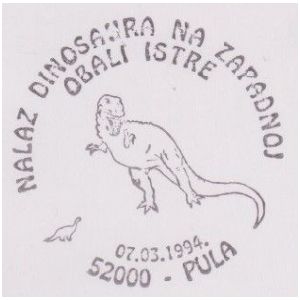 |
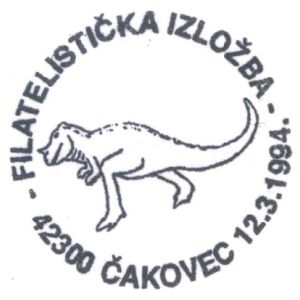 |
| 20.03.1994 "XLII International philatelic exhibit in Zagreb" | 30.10.1995 "Croatian Scientists" [1] [FDC] | 15.11.1995 "Philately event at Izlozba" [Sp] |
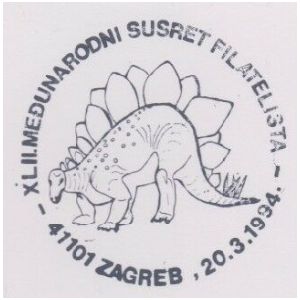 |
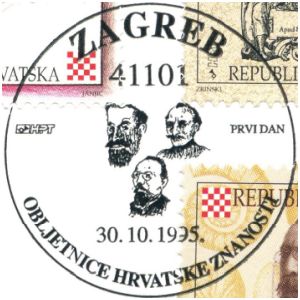 |
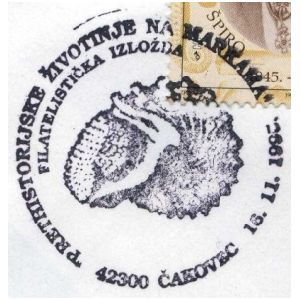 |
| 04.10.1996 "Scientist" [2] [FDC] | 06.11.1997 "Paleontological Finds in Croatia" [FDC] | 08.11.1997 "Philately event at Novska" [Sp] |
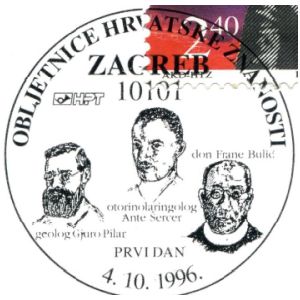 |
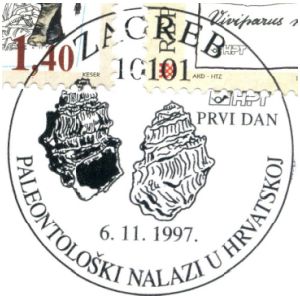 |
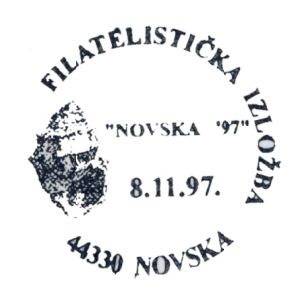 |
| 28.03.1998 "Philatelic exhibit: Dinosaurs on stamps" [Sp] | 18.05.1998 "International Museum Day: Museum of the Krapina Neanderthal Man" [Sp] | 24.07.1998 "12. International congress of Anthropology and Ethnography in Zagreb" [Sp] |
 |
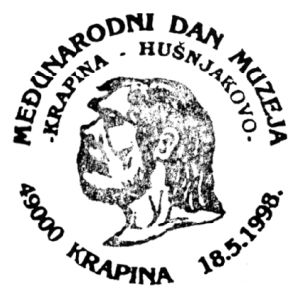 |
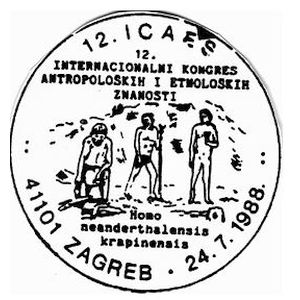 |
| 04.09.1998 "Philatelic exhibit: 100th anniversary discovery of the Krapina Neanderthal Man" [Sp] | 23.08.1999 "100th anniversary of discovery of Early Primitive Krapina Man" [FDC] | |
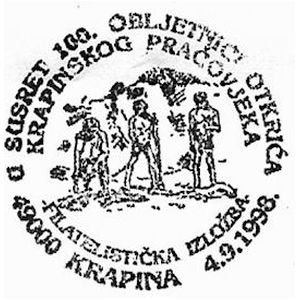 |
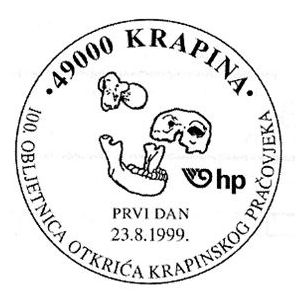 |
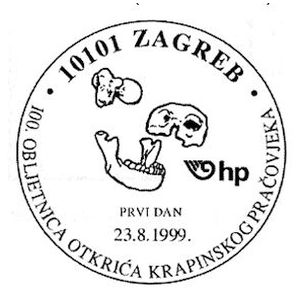 |
| 23.08.1999 "100th anniversary of discovery of Early Primitive Krapina Man" [FDC] | 23.08-12.09.1999 "Krapinaphila'99 100 anniversary discovery of the Krapina Neanderthal Man" [Sp] | 23.08.1999 "International conference 'Krapina Neanderthals and human evolution in central Europe' " [Sp] |
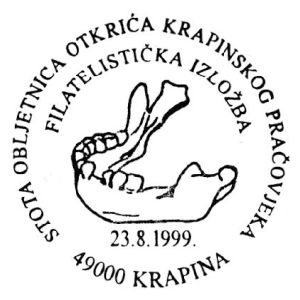 |
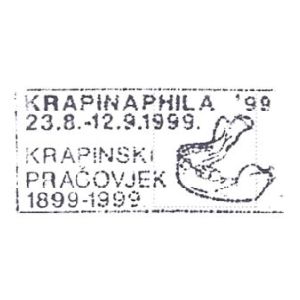 |
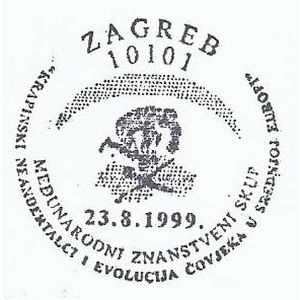 |
| 10.09.2000 "Crophilex 2000" [Sp] | 25.10.2006 "150th anniversary of Dragutin Gorjanović-Kramberger" [PM1] [Sp] | |
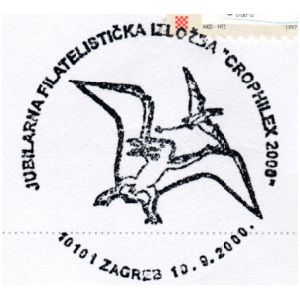 |
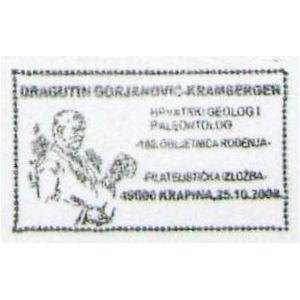 |
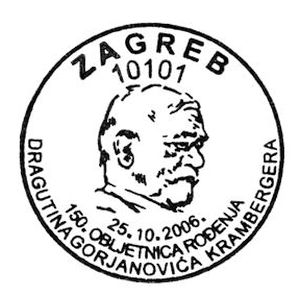 |
| 22.11.2008 "1. Paleontological monuments of the nature at Hušnjakovo hill, 1948-2008" [PM2] [Sp] | 20.04.2009 "Festival of famous personalities" [Sp] | 07.11.2012 "Museum of Krapina Neanderthal Man" [PM3] [FDC] |
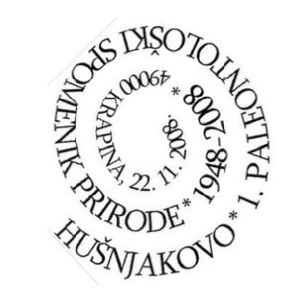 |
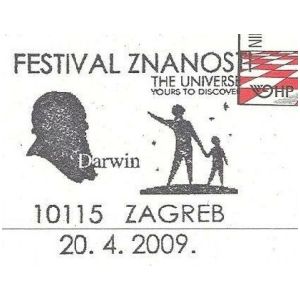 |
 |
| 12.11.2012 "Museum of the Krapina Neanderthal Man" [PM1] [PM3] [Sp] | 12.10.2016 "PALAEONTOLOGY" [FDC] | 22.12.2016 "160th anniversary of Dragutin Gorjanović-Kramberger" [PM1] [PM3] [Sp] |
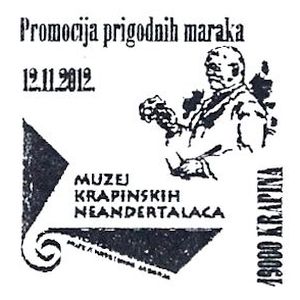 |
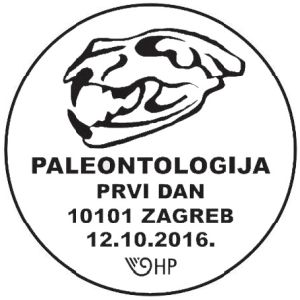 |
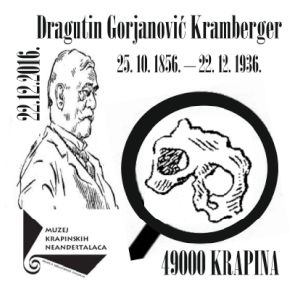
|
Notes:
[PM1] Dragutin Gorjanović-Kramberger was a Croatian geologist, paleontologist, and archaeologist, who discovered in 1899 very rich Neanderthal remains in a cave on Husnjak hill near Krapina town of an early man today known as Krapina Man. Dragutin Kramberger shown on Croatian stamp in 1999 and several Croatian and Yugoslavian commemorative covers and postmarks.
[PM2]
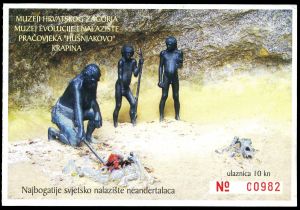
|
| Entrance ticket to Krapina Neanderthal Museum |
[PM3] "The Museum of Evolution was opened to public in September 1971. Its holdings contain geological, paleontological and archaeological collections, while the concept of the permanent exhibition focused on rocks and minerals of Croatian Zagorje, the evolution of life on Earth and the evolution of man with special emphasis on the Krapina Neanderthals. The exhibit on the Krapina Neanderthals includes casts of their bones, a collection of animal fossils from the same site, stone tools and documentation on their discovery. At the time of founding, the Museum of Evolution was part of the Forest Improvement Fund of the municipality of Krapina, and in 1971 it was transferred to the Zagreb Forestry Estate. In 1977 the organization “Krapina Early Man’s Site” was founded, and was made part of the Centre for Culture, Arts and Information in Krapina in 1988. Only in 1993 did the Museum become property of the Republic of Croatia. The construction of the new Krapina Neanderthal Museum lasted 11 years, and the Museum opened its doors to the public on February 27, 2010." [R3]
Other postmarks of Croatia to consider: contributors to Paleontology science.
| 23.04.2013 "50 year of death of Dr. Ivo Horvat" [PS1] [Sp] | ||
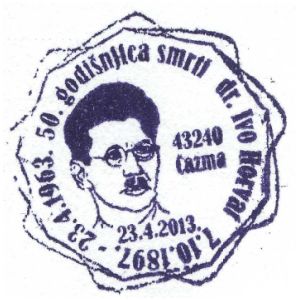 |
|
|
References:
- [R1] Croatia: Wikipedia, WikiTravel, FlagCounter.
- [R2] Postal History and Philately of Croatia:
Wikipedia,
Links to official website of the Post Authority, stamp catalog and a list of new stamps of Croatia are here. - [R3] Krapina Neanderthal Man: Wikipedia, ice-age-europe.eu, Krapina Neanderthal Museum.
- [R4] Dragutin Gorjanović-Kramberger: Wikipedia, encyclopedia.com.
- [R5] Spiridon Brusina: Wikipedia, Wikipedia (German version is more detailed)
- [R6] Gjuro Pilar: Wikipedia, enciklopedija.hr.
- [R7] Paleontological monuments on Hušnjakovo hill: Croatian scientific bibliography.
Acknowledgements:
Many thanks to Dr. Peter Voice from Department of Geological and Environmental Sciences, Western Michigan University, for the draft page review and his very valuable comments.
| << previous country | back to index | next country >> |